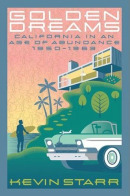Golden Dreams: California in an Age of Abundance | By Kevin Starr | Oxford University Press | 576 pages, $34.95
All is not well in California. As has been widely noted, our state is broke–and perpetually on fire. Its legendary thirst for water is looking risky as the West dries up, and the U.C. system, a flagship of public education, is being flayed by budget cuts. Not to mention the controversy over gay marriage, which continues to smolder long after Proposition 8. Even the most jaded among us Californians can’t help asking ourselves, “How did we get here?”
 Kevin Starr’s Golden Dreams: California in an Age of Abundance provides no easy answers to that question. But it does offer the reader a thorough and fascinating look at where many of these dramas began–during the postwar boom of 1950-1963.
Kevin Starr’s Golden Dreams: California in an Age of Abundance provides no easy answers to that question. But it does offer the reader a thorough and fascinating look at where many of these dramas began–during the postwar boom of 1950-1963.
Often pigeonholed as a decade of rising prosperity and crushing conformity, the Fifties actually had a lot bubbling under the surface. It was in this period that many of the public works projects, demographic trends, major institutions and grand political compromises that came to dominate life in California were put in motion. That would include everything from the first wave of suburban expansion and the construction of aqueducts and freeways to the drafting of the Master Plan for public education, not to mention a handful of landmark civil rights decisions in an era of de facto segregation. Culturally speaking, it was a period of strange quietude: after the Beats but before the Free Speech Movement, when sleek modernism existed alongside the baroque kitsch of Tiki.
Golden Dreams is the sixth volume in Starr’s epic history of California, and the appearance of each new installment has deservedly become an event. Besides the scope of the project, what has made this series such a hit is Starr’s ability to synthesize individual stories and larger social trends into what he calls “biography in brief.” With this technique, Starr seeks to “dramatize the achievements, ambiguities, and conflicts of this era.”
His best chapters—on politics, architecture, suburban sprawl, higher education and people of color–are all built around one or more of these snapshot bios. The captivating subjects include Earl Warren, caught up in a centrist balancing act as governor before he spread his liberal wings as a justice; Pat Brown, setting in motion the aqueduct that would later be named after him; “Trader” Vic Bergeron, mixing the first Mai Tai in Oakland; and a young Susan Sontag having tea with a self-impressed Thomas Mann.
In other cases, it is an idea, not an individual, that inspires the author. The opening chapter, on suburbia in the San Fernando Valley, is one such subject, and it elicits some of Starr’s most animated prose:
Family! It remains a mystery why an entire generation should so precipitously march en masse into marriage and childbearing in these years (after all, the children and grandchildren of this wartime generation would, beginning in the late 1960s, half-disestablish marriage as a compelling institution) beyond the notion that this was the image of the good life that had been promoted during the war: the vision of marriage, children, and a dream house cited ceaselessly in public reference, extolled in the popular media, explored at length in the pages of Ladies’ Home Journal. A tidal wave of marriage, sexuality, procreation, and family building followed the annihilations, global and personal, of the war years.
But when Starr tries to juggle too many subjects at once, he falters: individuals devolve into thumbnails, and vague, zeitgeist-y terminology takes center stage. This is most grating and apparent in his chapter on San Francisco. In Starr’s view, the city is caught between its “high provincial” past and its increasing status as a center of diversity and self-reinvention–what columnist Herb Caen called “Baghdad by the Bay.” So dogged is Starr in applying these rubrics that nearly everything gets filed under one label or the other, to the point of losing all interpretative value. It’s chapters like this one that occasionally make the nearly 600 pages feel like a trudge. Still, they’re fairly rare, and Golden Dreams remains a reliably engaging read.
At a moment when the state seems at a loss as to which abyss it will careen into first, Starr’s book offers a portrait of a time when so much still seemed possible: financially, of course, but also socially, artistically, and so on. Developers were reinventing the ranchland of the San Fernando Valley as a mega-suburb, even as writers were retreating to artistic compounds in Carmel. Reading Golden Dreams, one gets the sense that this period saw the last, fervent stand of Modernist moxie in the West. In fact, it’s the nakedly utopian ambition (for better and worse) of the Fifties that seems most distant from us now. But as initiatives calling for a new constitutional convention circulate, perhaps the ability of Californians to rip it up and start again hasn’t vanished altogether.
Click here for a complete Page Views archive.
Toby Warner is a writer and editor living in Oakland, Calif. He is the managing editor of Boldtype, an online magazine about books, and a PhD candidate in Comparative Literature at UC Berkeley, where he focuses on Francophone African literature.
